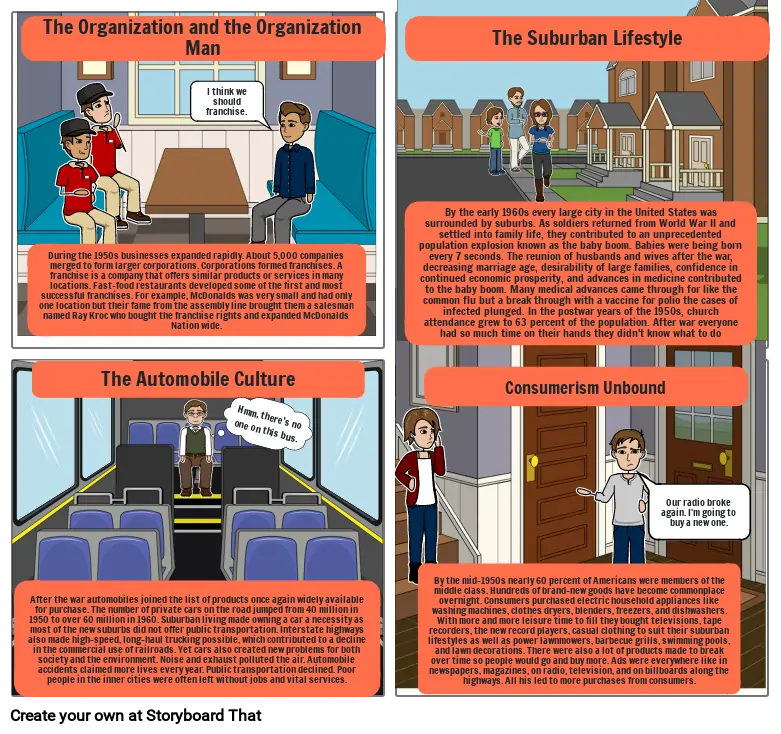Big Business Storyboard

Storyboard Text
- The Organization and the Organization Man
- During the 1950s businesses expanded rapidly. About 5,000 companies merged to form larger corporations. Corporations formed franchises. A franchise is a company that offers similar products or services in many locations. Fast-food restaurants developed some of the first and most successful franchises. For example, McDonalds was very small and had only one location but their fame from the assembly line brought them a salesman named Ray Kroc who bought the franchise rights and expanded McDonalds Nation wide.
- I think we should franchise.
- By the early 1960s every large city in the United States was surrounded by suburbs. As soldiers returned from World War II and settled into family life, they contributed to an unprecedented population explosion known as the baby boom. Babies were being born every 7 seconds. The reunion of husbands and wives after the war, decreasing marriage age, desirability of large families, confidence in continued economic prosperity, and advances in medicine contributed to the baby boom. Many medical advances came through for like the common flu but a break through with a vaccine for polio the cases of infected plunged. In the postwar years of the 1950s, church attendance grew to 63 percent of the population. After war everyone had so much time on their hands they didn't know what to do
- The Suburban Lifestyle
- After the war automobiles joined the list of products once again widely available for purchase. The number of private cars on the road jumped from 40 million in 1950 to over 60 million in 1960. Suburban living made owning a car a necessity as most of the new suburbs did not offer public transportation. Interstate highways also made high-speed, long-haul trucking possible, which contributed to a decline in the commercial use of railroads. Yet cars also created new problems for both society and the environment. Noise and exhaust polluted the air. Automobile accidents claimed more lives every year. Public transportation declined. Poor people in the inner cities were often left without jobs and vital services.
- The Automobile Culture
- Hmm, there's no one on this bus.
- By the mid-1950s nearly 60 percent of Americans were members of the middle class. Hundreds of brand-new goods have become commonplace overnight. Consumers purchased electric household appliances like washing machines, clothes dryers, blenders, freezers, and dishwashers. With more and more leisure time to fill they bought televisions, tape recorders, the new record players, casual clothing to suit their suburban lifestyles as well as power lawnmowers, barbecue grills, swimming pools, and lawn decorations. There were also a lot of products made to break over time so people would go and buy more. Ads were everywhere like in newspapers, magazines, on radio, television, and on billboards along the highways. All his led to more purchases from consumers.
- Consumerism Unbound
- Our radio broke again. I'm going to buy a new one.
Peste 30 de milioane de Storyboard-uri create

